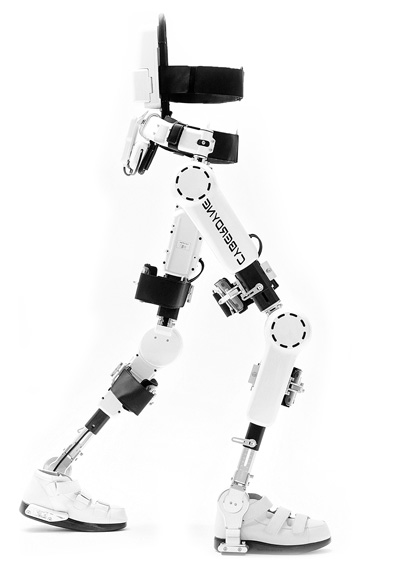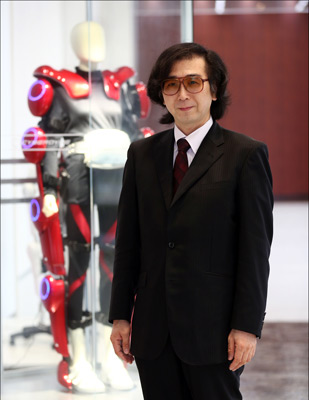Do you know someone in a wheelchair? What if I tell you there is a way that this person can walk again? That all it takes is a robot suit that reads your mind. What if you too could wear this exoskeleton to gain the strength of a Hulk or a Superman and help people? Would you believe me if I said all this was possible? Japanese robotics company CYBERDYNE has created one such exoskeleton, that is, a device designed to be worn by a human. This Hybrid Assistive Limb (HAL) can detect and reproduce the wearer’s intention to move by reading signals from the brain. According to CYBERDYNE’s CEO, Dr. Yoshiyuki Sankai, HAL is unique in that there is no other technology of its kind to compare with. “Our aim was to treat, improve, support and enhance human physical functions,” he tells me. Well, HAL does just that.
Not just a robot suit
This is not just a robot suit. HAL’s innovative interactive biofeedback system (iBF technology) allows it to not only read bio-electrical signals from the user but also reflect the wearer’s intention to move. iBF promotes functional improvement, acquisition and brain regenerations, in patients with nerve and muscle disorder whose numbers are increasing due to our ageing society.
It has been a long road; Dr. Sankai has been working on this project since 1991. But its potential to dramatically transform and improve the quality of life of millions of people has been worth the effort.
Taking care of you

HAL comes as part of a wave of advances in robotics aimed at creating devices that help us carry out many of our daily activities. With its “personal care robots”, this expanding industry responds to the challenges presented by ageing populations requiring more support, low birth rates restricting the available labour force, and modern lifestyles that leave little time for day-to-day tasks. It is no surprise that CYBERDYNE originated in Japan, the cradle of modern robotics. But will this innovative technology be easily adopted by the elderly? Dr. Sankai seems to think so. “If it is truly useful with an ergonomic design that takes psychological considerations into account, it will.”
And this is just the tip of the iceberg. HAL is not only expected to assist the aged and people with restricted and impaired mobility, it will also support able-bodied workers who could benefit from the enhanced physical abilities. One example is nurses who regularly need to carry patients, or rescue workers who might have to lift victims out of difficult disaster zones without the intervention of potentially destructive large machinery. At this point, the possibilities seem endless.
First of its kind
HAL is the first of its kind in terms of integration between humans and robots. But is it safe to use? “We have extensively considered and addressed the risks in the development process,” explains Dr. Sankai. At present, the main challenge is that it is difficult to find a light and compact actuator (motor that controls the system) that moves with the same speed and power as a human joint. The device will not exceed the speed of human joints, so as to keep the risk of hitting and collision at a low level.

This raises the question: who makes sure that new devices like HAL are not dangerous? Because the world has not seen anything like these robots before, there is no legislation in place to protect users. International Standards are therefore crucial for creating confidence in these products. I asked Dr. Sankai if this is one of the reasons why CYBERDYNE became an early adopter of ISO 13482, the first standard on safety requirements for personal care robots. Published in 2014, CYBERDYNE applied it while still a draft.
“CYBERDYNE is not just a user of the standard,” explains Dr. Sankai, “We were also actively involved in its development. And that is because we believe that it is our company’s mission to contribute to society by participating in the development of International Standards, so that we can help build a solid and reliable infrastructure for this new industry.”
Dr. Sankai emphasizes the importance of international collaboration and academic development. CYBERDYNE sees itself as a leader demonstrating by example. “By being an early adopter of ISO 13482, we were able to better understand the procedures needed for its implementation, including any challenges and benefits resulting from its use. We believe that our experience will help other companies to apply ISO 13482.”
Interestingly, CYBERDYNE also participates in the ISO technical committee responsible for medical robots. As Dr. Sankai puts it, “ISO 13485 is the global standard for quality management systems for medical devices. Planning ahead, we developed our products to be compliant with ISO 13485 before even obtaining ISO 13482, so that we can position our products in both the medical and personal care industries.”
More than just a 2 and a 5
CYBERDYNE considered ISO 13485 a necessity to distribute HAL as a medical device. “ISO 13482, on the other hand, was important to develop and ensure the safety of personal care robots for non-medical use, which is the new industrial flagship of the next generation,” explains Dr. Sankai. “We believe that in the future, requirements for products like ours, which are in the boundary between hospital and home life, will be integrated. So complying with both standards is essential for us,” says the CEO.
The personal care robot industry is here to stay and its potential to benefit society is enormous.
For Dr. Sankai, perhaps the most important advantage of ISO 13482 is that it will open up the market for a new generation of robots. Up until now, robotic devices have been required to comply with high safety regulations akin to those of the medical industry, but which are not necessarily always appropriate for this technology. This might make sense for CYBERDYNE, but for other companies, these stringent requirements have simply created entrance barriers.
Safety levels for personal care robots remain under discussion as the technology is still in its infancy. But for Dr. Sankai, the standard provides a base on which this innovation can grow and flourish, accompanying technological developments and protecting users on this pre-dawn phase. In this way, the standard levels the playing field for new companies wishing to enter the emerging industry.
“ISO 13482 is not difficult to apply and should be a good standard for many companies to receive certification and get started in the domain of personal care robots,” says Dr. Sankai.
This is one example where standards can pave the way for innovation. But how much is too much? The CEO advises that we must tread carefully in order to make sure we do not develop inadequate standards, and rather than second-guess technology, go hand in hand with it.
Machine over human
 Dr. Yoshiyuki Sankai, CEO of CYBERDYNE.
Dr. Yoshiyuki Sankai, CEO of CYBERDYNE.
The personal care robot industry is here to stay and its potential to benefit society is enormous. But I can’t get rid of that nagging reminder from science fiction stories depicting dystopian worlds where robots take over our lives. Could this be the future? Dr. Sankai reassures me, “Washing machines, radios, cell phones, PCs, and so on, have high levels of autonomous functions, just like robots. They are not scary at all!”
“If you look at it that way, you realize that there is no reason for people to be only afraid of ‘robots’. When I was child, among my stuffed toys, there was one with a spooky face...”
More seriously, he adds: “At present, and in the near future, people will not be able to develop robots whose killing power exceeds that of machine guns, toxic gases, missiles or nuclear and biological weapons. In fact, it is not robots but weapons equipped with automation technology that are both dangerous and horrific.”
The CEO goes on to tell me about a new academic field in which CYBERDYNE is actively involved through the University of Tsukuba in Japan. He calls it “Cybernics: a new domain of interdisciplinary academic field centered on cybernetics, mechatronics, and informatics”.
“In this discipline, we believe that social sciences like philosophy, ethics and law should be at the heart of our ideas, in addition to technology and science. And that scientists, researchers and engineers have a responsibility to adopt this approach.”
HAL is unique in that there is no other technology of its kind to compare with.
Do robots have an advantage over humans? “In actual life, robots and people will exist cooperatively, so we cannot jump to conclusions on which is superior,” explains Dr. Sankai. “Machines make up for areas where people are not good and vice versa. Technology should be beneficial to human life.”
“For people who, like us, are involved in new technologies, such as personal care robots, it is important to have a long-term vision of how these technologies will impact the future of society and their consequences. At CYBERDYNE, our philosophy is to develop technologies that enable people to help each other. We call this ‘techno peer support’.”
So I asked Dr. Sankai whether he would call HAL the first cyborg. “No,” he answers. “He is the world’s first cyborg-type robot.”

